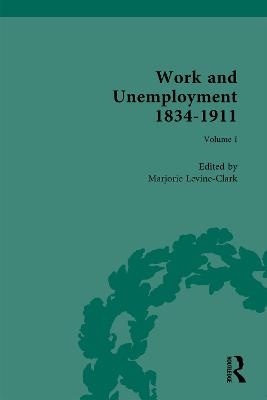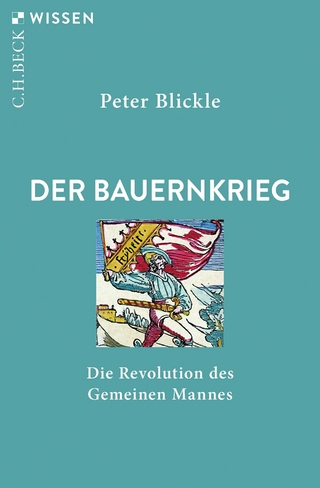
Work and Unemployment 1834-1911
Routledge (Verlag)
978-0-367-33515-1 (ISBN)
This volume examines the ideals and experiences of work during the long nineteenth century. The meanings attached to work had resonance in multiple aspects of people’s lives, and the sources consider this breadth. The primary sources examine the association of work with respectability, the challenges industrialization posed to men’s traditional labour and identities, and the pressures placed on working women by the increasingly normative domestic ideal. Accompanied by extensive editorial commentary, this volume will be of great interest to students of British History.
Marjorie Levine-Clark is Professor of History at University of Colorado Denver, USA
Volume 1: The Meanings of Work
Part 1: The Respectability of Honest Toil
1. W. Cobbett, ‘To the Labourers of England, on their Duties and their Rights’, Cobbett’s Weekly Register 71:5 (1831), pp. 285-90.
2. J. Livesey, ‘An Address to Working Men’, J Livesey’s Moral Reformer, 13 (1838), pp. 97-8.
3. J. F. Bray, Labour’s Wrongs and Labour’s Remedy (1839), pp. 22-4.
4. Anon., ‘The Production and Distribution of Wealth’, Chartist Circular, 38 (13 June 1840), pp. 153-4.
5. J. Adshead, Distress in Manchester-Evidence (Tabular and Otherwise) of the State of the Labouring Classes in 1840-42 (London: Henry Hooper, Pall Mall East, 1842), pp. 25-30.
6. The British Workman on the Nobility of Labour
6.1. M. Howitt, ‘The Labourer’s Thanksgiving Hymn’, The British Workman (1856), p. 91.
6.2. Rev N. Hall, ‘The Dignity of Labour’, The British Workman (1856), p. 9-10.
6.3. ‘The Working Man’, The British Workman (1859), p. 215.
7. Rev. A. Oxenden, ‘The Labourer at His Work’ in The Labouring Man’s Book (London: Wertheim, Mackintosh, and Hunt, 1860), pp. 47-61.
8. Dr J. C. Hall, The Trades of Sheffield…Read before the National Association for the Promotion of Social Science, 2nd ed. (London: Longmans, Green and Co, 1865), pp. 7-21.
9. J. B. Glasier, ‘Honest Toil’, (Penny Pamphlet, Socialist League: c. 1890).
10. G. Milligan, ‘A Man and His Work’, ‘Only a Working Man’, and ‘The Toiler’s Toast’ in Life Through Labour’s Eyes (St. Louis: B. Herder, 1911), pp. 11-14, 92-7, and 167-9.
Part 2: Men and Machines
11. Society for the Diffusion of Useful Knowledge, The Working Man’s Companion-The Results of Machinery … An Address to Working Men (London: Charles Knight, 1831), pp. 5-8, 16-21, 24-6, 179-80, 182-90.
12. Anon, The Petition of the Undersigned Operative Spinners and Others Employed in the Spinning of Cotton Wool into Yarn, in Ashton-under-Lyne and Its Neighbourhood (T. Cunningham, 1832). Considered by House of Commons on Feb 22, 1832, p. 136.
13. G. C. Burrows, ‘Introduction’, ‘Letter I’, Letter VI, and Appendix in A Word to Electors. Letters to the Present Generation on the Unrestrained Use of Modern Machinery Particularly Addressed to my Countrymen and Fellow Citizens (Norwich: Wilkin and Fletcher, 1832), p. 3, 4-5, 23-6, and 28-30.
14. Debating Political Economy and the Condition of the Handloom Weavers
14.1. G. P. Scrope, Political Economy versus the Hand Loom Weavers, the Letter of George Poulett Scrope, Esq., M.P., to the Chairman of the Central Committee of the Hand Loom Worsted Weavers (Bradford: H. Wardman, 1835), pp. 2-5.
14.2. J. Dewhirst, ‘To George Poulett Scrope, Esq., M.P.’, Poor Man’s Guardian, 1 August 1835, pp. 618-21.
15. J. Maxwell, Manual Labour versus Machinery (London: Cochrane and M’Crone, 1834), pp. 6-9, 12-15, 17-29, 31.
16. Anon, ‘The Present Condition of British Workmen’, Broadside, 1834.
17. H. Leggeth and S. Cowle, ‘An Address to the Female Chartists of Manchester to Their Sisters of England, Ireland, Scotland, and Wales’, Northern Star, 24 July 1841, p. 8.
18. W. Carpenter, ‘The Question of Machinery Fairly Stated’, ‘Machinery Creates a Demand for Manual Labour’, and ‘Condition of the Hand-Loom Weavers’, in Machinery as it affects the Industrial Classes and the Employment of Children in Factories (London: E. Lloyd, 1844), pp. 10-11, 21-4, and 28-30.
19. Literary Depictions of Mechanization
19.1. C. Dickens, extract from ‘The Key-Note’, Hard Times (London: Bradbury & Evans, 1854).
19.2. B. Brierley, Chapter II of ‘Out of Work, in Tales and Sketches of Manchester Life (Manchester: Abel Haywood & Son, 1885), pp. 27-32.
20. J. Samuelson, ‘Introductory’, ‘ The Displacement of Hand-Labour in Agriculture’, ‘Displacement of General Labourers by Machinery’, and ‘Inferences – The General Question of Labour – Conclusion’, in Labour-Saving Machinery (London: Kegan, Paul, Trench, Trübner, & Co. LTD., 1893), pp. 1-13, 66-80, and 91-4.
Part 3: Women’s Work: Productive and Reproductive
21. J. Livesey, ‘To the Females Employed in Factories and all our Large Manufacturing Establishments’, Moral Reformer, 2 (1 February 1832), pp. 37-46.
22. Chartist Women
22.1. Anon., ‘Miss Mary Anne Walker on the People’s Charter’, Northern Star, 10 December 1842, p. 7.
22.2. S. Price, ‘Address of the Female National Charter Association of Upper Honley and Smallthorn’, Northern Star, 29 January 1842, p. 17.
23. Reports of Special Assistant Poor Law Commissioners on the Employment of Women and Children in Agriculture (London: Clowes and Sons, 1843), pp. 3-6, 9-13, 17-19, 22-28.
24. E. Copley, ‘Introduction’ to The Young Women of the Factory, or Friendly Hints on Their Duties and Dangers (London: The Religious Tract Society, c. 1840), pp. 1-4.
25. Anon., ‘Female Education and Female Labour’, The Artizan, A Monthly Journal of the Operative Arts, 1 (1845), p. 147.
26. M. F. Tupper, ‘The Workwoman’, in A Dozen Ballads for the Times about White Slavery (London: T. Bosworth, 1854), pp. 16-17.
27. Sentimental Depictions of Working-Class Women in The British Workman
27.1 Anon, ‘A Few Words to the Wives of Working Men’, British Workman, 2 (1856), p. 7.
27.2 Anon, ‘Finery and Freedom, or "Lucy’s Choice"’, British Workman, 45 (1858), pp. 177-8.
28. A. Munro, Our Unemployed Females and What May Best Be Done for Them (1863), pp. 26-38.
29. T. Wright, ‘Working Men’s Homes and Wives’, in The Great Unwashed (London: Tinsley Brothers, 1868), pp. 30-41.
30. J. B. Kinnear, ‘The Social Position of Women in the Present Age’, in The Right of Women to Labour (London: Frederick Bell & Co., 1873), pp. 3-14.
31. M. Harkness, ‘Palm-Workers’ in Toilers in London; or Inquiries Concerning Female Labour in the Metropolis (London: Hodder and Stoughton, 1889), pp. 47-57.
32. G. Reid, et al, ‘Legal Restraint upon the Employment of Women in Factories Before and After Childbirth’, British Medical Journal II (30 July 1892), pp. 275-8.
33. Anon, ‘Health of Lead Workers’, Labour Gazette 1 (December 1893), p. 197.
34. E. Dilke, ‘Preface’, in A. Bulley and M. Whitley, Women’s Work (London: Methuen & Co., 1894), pp. v-xiii.
35. H. Bosanquet, Economics of Women’s Work and Wages (London: P.S. King & Son, 1907), p. 1-11.
Index
| Erscheinungsdatum | 20.05.2022 |
|---|---|
| Reihe/Serie | Routledge Historical Resources |
| Zusatzinfo | 10 Halftones, black and white |
| Verlagsort | London |
| Sprache | englisch |
| Maße | 156 x 234 mm |
| Gewicht | 453 g |
| Themenwelt | Geisteswissenschaften ► Geschichte ► Regional- / Ländergeschichte |
| Geschichte ► Teilgebiete der Geschichte ► Kulturgeschichte | |
| Geschichte ► Teilgebiete der Geschichte ► Religionsgeschichte | |
| ISBN-10 | 0-367-33515-8 / 0367335158 |
| ISBN-13 | 978-0-367-33515-1 / 9780367335151 |
| Zustand | Neuware |
| Informationen gemäß Produktsicherheitsverordnung (GPSR) | |
| Haben Sie eine Frage zum Produkt? |
aus dem Bereich


